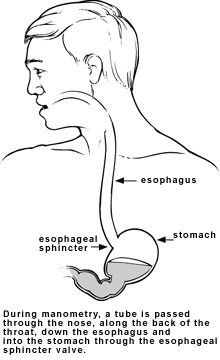Esophageal manometry
Esophageal manometry is a test that is used to measure the function of the lower esophageal sphincter (the valve that prevents reflux, or backward flow, of gastric acid into the esophagus) and the muscles of the esophagus. This test will tell your doctor if your esophagus is able to move food to your stomach normally.
It is important to undergo test before major surgeries of food pipe. It will help to assess post operative recovery and sometimes method of operation. It is day care test done nasalya without Anaesthesia. Patient need to visit doctor empty stomach for proper test results.
The manometry test is commonly given to people who have:
- Difficulty swallowing
- Pain when swallowing
- Heartburn and/or regurgitation (bringing food back up after swallowing it)
- Chest pain

The swallowing and digestive processes
When you swallow, food moves down your esophagus and into your stomach with the assistance of a wave-like motion called peristalsis. Any interference or problems with this wave-like motion may cause chest pain or problems with swallowing.
In addition, the lower esophageal sphincter (the muscular valve connecting the esophagus with the stomach) prevents food and acid from backing up out of the stomach into the esophagus. If this valve opens when it is not supposed to, food, acid and stomach enzymes can enter the esophagus and cause a condition called gastroesophageal reflux disease (GERD). If the lower esophageal sphincter is not opening during a swallow, it may be a sign of a condition called achalasia, which causes difficulty swallowing.
Digestive process
Digestive processes start from mouth. Chewing of food and mixing with saliva is important first step in digestion. It helps for digestion of carbohydrates and proteins. That’s why proper chewing and mixing is stressed as important since our childhood. Food pipe just transfers food into stomach. Stomach is epicentre of digestion where almost 60-70% work done. Stomach secrets multiple products like acid pepsin which metabolizes major part of food. After approximately 2 hours food transferred to small intestine. Small intestine is important part for passage of micronutrients into blood. Pancreatic enzymes and bile mixes with food into small intestine and helps for digestion of carbohydrates fat and proteins. It is also centre for absorption of iron and important vitamins. Large intestine is important for stool formation and water absorption. Function of large intestinal muscles is important for stool evacuation. Proper coordination of internal anal sphincter and external anal sphincter is required for proper evacuation of stool.


